|
FAQs about Fungiid Coral Health/Disease
5
FAQs on Fungiid Disease:
Fungiid Disease 1, Fungiid Disease 2, Fungiid Disease 3, Fungiid Disease 4, Fungiid Health 6, Fungiid Health 7,
FAQs on Fungiid Disease by Category:
Diagnosing,
Environmental (Pollution/Poisoning, Lighting...),
Nutritional, Social (Allelopathy),
Trauma,
Pathogenic (Infectious, Parasitic, Viral)
Predatory/Pest, Treatments
Related Articles: Coral Pests and Disease; pests, predators,
diseases and conditions by Sara Mavinkurve, Fungiid Corals,
Related FAQs: Fungiid
Disease 1, Fungiid Disease 2,
Fungiid Disease 3, Fungiid Disease 4, Fungiid Health 6, Fungiid Health 7, & Coral Disease, Fungiid Corals 1, Fungiid Corals 2, Fungiid Identification, Fungiid Behavior, Fungiid Compatibility, Fungiid Selection, Fungiid Systems, Fungiid Feeding, Fungiid Reproduction, Stony/True Coral, Coral System Set-Up, Coral System Lighting, Stony Coral Identification, Stony Coral Selection, Coral Placement, Foods/Feeding/Nutrition, Disease/Health, Propagation, Growing Reef Corals, Stony Coral Behavior,
|
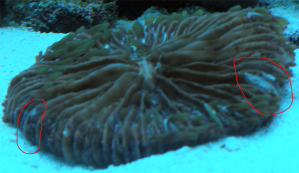
|
|
Plate Coral Problem
1/21/17
Good Afternoon, I found your site as a recommendation, but only seem to see
freshwater stuff. I apologize if I have reached you in error.
<No worries; all subwebs (including Marine) should show on our root:
http://wetwebmedia.com/
Fungiids in general here:
http://www.wetwebmedia.com/fungiidae.htm
and the linked files at top>
I have a plate coral that I have had for about 3 weeks.
<Mmm; Fungiids are easily lost; most species, but some are notorious>
It looked great and ate well up to a few days ago. I noticed the flesh
on top turning a bit white, and assumed that my diamond Goby had spit some sand
on it and irritated it.
<What they do>
I then put up a bit on a rock and it has continued to decline in appearance.
<Uhh; don't live on rock, but on the substrate>
I have attached pictures.
My parameters are:
Parameters:
S - 1.0245
pH - 8.2
NH3 - 0
No3 - 10
No2 - 0
Ca - 440
KH - 10
The day I noticed it, my parameters were:
Parameters:
S - 1.0245
pH - 8.2
NH3 - 0
No3 - 10
No2 - 0
Ca - 420
KH - 11
I was then told my Alk was a bit high,
<Not... 11, 12 is ideal>
and I've been working to move that down slowly. However, prior to this, my
parameters have been the same for longer than this coral has been in my tank.
Any idea why this coral wouldn't do well?
<All sorts of possibilities... The best route to have you go through the linked
files referenced above... The FAQs files Re Selection, Systems, Health/Disease
in particular>
All of the other corals I have are doing well, including a Acropora frag that I
have.
Any guidance would be much appreciated
Many thanks, Henry
<Please do write back after reading if your path is not clear. Bob Fenner>
|
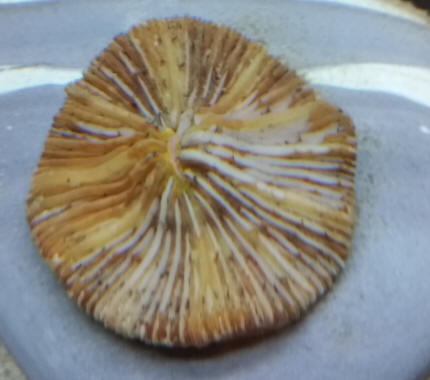 |
|
Fungia Frustration 10/17/15
I have attached a picture of a small plate coral, Fungia, I hope.
<Ah yes; I see it/this.... are those Dinoflagellates.... growing on your
substrate? Not BGA I hope/trust>
He has been a resident for about six weeks. He acclimated well, is on the sand
bed and moved himself to within 6 inches of a large mushroom. You can see his
skeleton receding in the area around his mouth. He eats mysis every few days.
Could he be weak from the proximity of the mushroom?
<Could be a factor; yes>
He moved to the current location, at this point is moving him away to<o>
stressful?
<I would let this animal move itself>
The tank is new, 6 months, 1.025 salinity, 0 ammonia or nitrite, 10ppm nitrate,
7.5 dKH, 400 calcium, 8.0 ph, no chemical additions.
<Good point, data. Oh; I would add a bit/dose of iodide-ate weekly; likely
during water changes>
The tank parameters seem stable with weekly 10% water changes, with ro/di water.
I have Kessil leds, the 160s.
The other issue is my bubble tip anemone, he has only been in the tank
for two weeks.
<Oh... could be a bit of allelopathy with this organism as well. Do you "mix
water" during quarantine? Please see my SOPs re archived on WWM. The best way of
introducing disparate (and competing) Cnidarians>
The first week he settled and ate. After a water change he moved during the
night. Next day he looks beat up, but improves his look over the last three days
to normal appearance. He is attached upside down(bad) in a plastic tube the fish
use, no apparent access to light. Should I assist him back to a better
position?
<... could you send a pic of this Anemone, its placement? I would NOT move it if
it can move itself>
There aren't any known predators in the tank,
<But, other competitors. Read here please:
http://wetwebmedia.com/CorlCompArt.htm
and as much of the linked files above till you feel you have a good
understanding of the situation>
he isn't damaged to look at. If it makes sense, looks like he was jostled
heavily, but now the third day without light. Since he is in a man made plastic
tube could he be confused, lost?
<Not likely; no>
Or could the anemone crab be irritating him to the point of seclusion?
<This is a possibility>
There are a couple of mushrooms and polyps on the other side of the tank, on the
bottom.
<... could be trouble>
He was elevated on rocks. Or is there some allelopathy and he is
retreating from that?
<Yes; this is the most likely, greatest factor>
Although he seemed good until the water change and any commotion in the tank
seems to upset him, like feeding or algae removal. Is this a sensitivity or
perhaps a weakness?
<I'd say a sensitivity and a strength>
Would another water change be more stressful or helpful?
<The reading; perhaps use of GAC, Polyfilter for now.... removal of some of the
competitors to isolation>
There is Chemi-pure in the filter.
<Ah, good; this is mostly GAC>
Just don't want to wait and see if something is amiss that I am not accounting
for. Btw your site and Karen's anemone sight are both so informative for myself
and others trying to provide for this creature. I'll continue to read.
<Ahh; thank you for your kind, encouraging words. Bob Fenner>
|
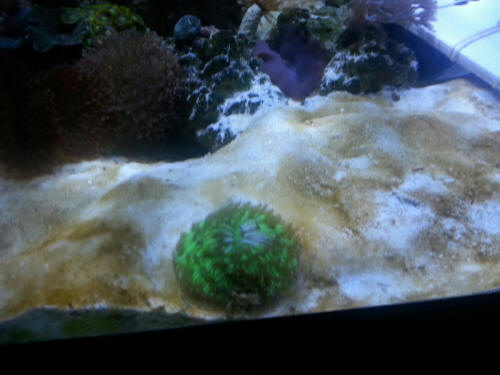 |
|
Re: Fungia Frustration 10/17/15
I took and attached a couple of pictures of my distressed bubble tip anemone.
His color is accurate, though he doesn't seem to accept food, obviously
struggling but the cause I am unsure of. Would you remove the crab? Or move the
anemone at this point? Your assistance is invaluable.
<Unless you have some other system; I would move neither. Search WWM re
Entacmaea; and READ. BobF>
|
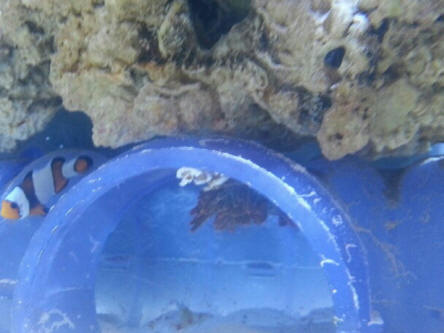 |
|
Tongue coral tissue recession.
8/3/15
Hi, I am hoping you can give me some advice about a tongue coral I recently
bought. I noticed at the shop where I bought it that it had a little bit of
receding tissue at one end but I thought that since the exposed bits were dark,
rather than fresh white looking, that it was old damage and the coral would be
ok. It is about five inches long and seems to be doing well in my tank so far,
my "plan" was to feed it well several times a week to help it recover. It does
eat well when I feed it Mysis and small pieces of scallop.
It is on the sand in bright light and medium flow. Can you let me know
what else I can do to help it along or if I made a mistake in buying it
and they don't recover from tissue damage?
<Mmm; yes. Have you tried a few times (over) dosing of iodide-ate? Not
to worry re the initial high/er concentration... I would do this rather than a
bath/dip procedure. Also... Fungiids really prefer finer substrate; even much...
rather than coarse sand. Do please read what we (WWM) have archived re the
husbandry of this family>
I have attached the best picture I could get of the damaged end.
Thanks, Chris.
<Welcome. Bob Fenner
|
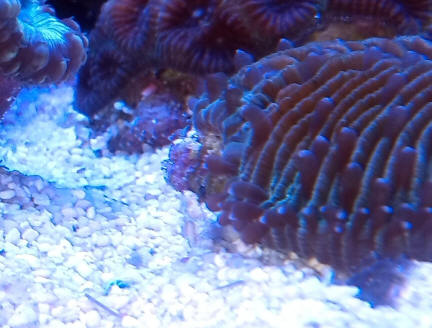 |
|
Saltwater aquarium question. Fungiid beh., hlth.
6/2/15
Hi, I'm hoping someone can give me a bit of advice on a new orange plate
coral I got last week. It just doesn't seem to be doing great
since I put it in the tank,
<Common for these species>
not swelling up and putting out tentacles like my other green one and I think it
might be losing a bit of colour, going a little duller maybe (I'm not quite sure
about that though because my vision is colour deficient so can't really tell for
sure). It also doesn't seem to have the same kind of mouth that my green one
has, just a pale bit in the middle, the green one has a very obvious mouth but
not this one. Anyway there's a picture of both so you can see what I mean. Does
it look ok?
<A little puffy, but...>
Also I moved it to a slightly shady spot with less flow because I wondered if it
was getting too much light or to much flow.
http://i215.photobucket.com/albums/cc280/fluffy_stitch_jodi/Orange%20plate%20coral.jpg
http://i215.photobucket.com/albums/cc280/fluffy_stitch_jodi/Green%20plate%20coral.jpg
Thanks,
Chris.
<Have you read on WWM re the health, keeping these animals? Administered
iodide-ate? Bob Fenner>
|
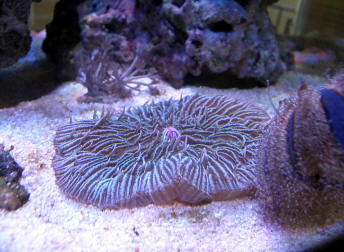
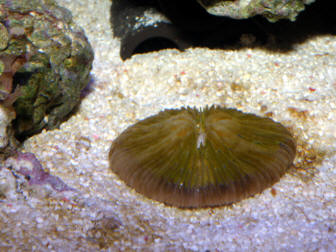 |
Re: Plate coral not listed in FAQ
2/7/14
Thank you for your fast response. I read all the Fungiid
diseases and came up with tissue recession.
<Okay; so what are you going to do?>
Would you say this much is severe? Would dipping the coral in coral
rx help bring him back or hurt more than help.
<I'd just use iodide-ate>
On you website a response to a orange plate similar to mine y'all said it
was tissue recessing, but didn't give any advice on how to help him out
other than removing a peppermint in that situation and I do not own a
peppermint shrimp. Thank you, and I appreciate your specific id on
my coral. Your website is awesome.
<Agreed. BobF>
|
Fungi<a> with strange parasite
12/9/11
Hello,
Thank you for taking my question.
<Welcome>
One of my recent additions is this lovely orange Fungia. It
looked very healthy at the LFS and continues to look healthy in
the tank. I dipped the coral in Lugos
<Lugol's; not my choice in iodide-ate soln's of
use>
solution prior to adding to the main tank. It is quite active
(moves around) and prefers to be snuggled into a large doughnut
coral (green).
<Mmm>
One evening I noticed what appeared to be an 8" long strand
of hair attached to the Fungia. Upon closer observation, there
were two 8" long "antennas".
Each "antenna" has numerous smaller hairs combing the
water column. Where the hairs are attached to the Fungia
is a small opaque blob. This blob can pull in the
"antenna" when disturbed or when it catches something
tiny.
During the day, the "antennas" are not visible. This
blob slowly moves under the surface of the coral daily.
I removed the coral, placed in shallow bowl and tried very
carefully to scrape the blob off. I did manage to get some slime,
but...? A few days back in the tank and the blob was visible and
moving.
This coral is about 3" round, tentacles extend, tissue puffs
up, it moves around and seems healthy other than this parasitic
hitch hiker on it. I just don't want the blob to make more
blobs or endanger the Fungia.
<Understood>
Today, I finally got a good picture of it. In this picture the
blob looks like a tiny star fish, but it is not a star fish and
seems to be under the tissue. The blob is becoming more visible
than it was a month ago.
Any advice on what it is or how I can get rid of it?
<Can't make this organism out in your pic... even w/
enlargement, optimization. IF you have a larger, better-resolved
image, please send it along. This may be (my first guess) a
Hydrozoan of some sort... a stinging hydroid. Whatever it is, the
treatments applied by folks for Aiptasia/Glass Anemones are
avenues to try. Yes; may kill the immediate area around... but
this Fungia should be able to regenerate this in time>
Background: Tank is 150 gallon reef, 30 gallon sump, 15 gallon
refugium, AquaC skimmer, 3 power heads, 1 year old (much
livestock/live rock transferred from my 3 year old tank), 200
pounds live rock, various hermits, 9 healthy fish, 3 clams,
brittle stars, various corals, 81 degrees F, Orphek LEDs, 10%
water changes weekly, no current algae problems, I feed 8
different types of foods (frozen, flake, pellet, live, freeze
dried), all water parameters good... I could go into more detail,
but this question is regarding the parasite.
<Ahh!>
Wet Web Media has been so helpful to me. Thank you. I can try
taking better photos if needed.
Sincerely,
Wendy
<Please do. Bob Fenner>
|
|
 Full size pic Full size pic
|
|
Happy Fungia Unraveling Fast: Mysterious Tissue
Transfer Matter, or Attack of the Benthic Ctenophores?
10/30/11
A "Hola!" Bob and Crew!
<Howdy Alex!>
I wouldn't write if I could find anything conclusive online,
and so far I have not found much...
I am concerned about the smaller of my two Fungia specimens. It
has, over the last two or three days, developed several (2-5
visible at a time) jellyfish-like tentacles that drift and trail
string-like from the edges of the polyp.
<I see these in your excellent pix>
All the typical tentacles are extended like normal, and the
Fungia still seems content most of the time: its polyp is almost
always inflated, except when it exhales... The thing is, these
stringier tentacles don't resemble any coeloplana I was able
to look up (only one image I saw involved a Fungiid anyway);
everything I saw online had more feathery or spider-webby
strands.
<These look mysteriously like some types of stinging Hydroids
I've seen on various Scleractinians over the years...
>
The ones on my coral have one smooth strand paired with a much
more rippled strand, connected by a transparent strip of
tissue.
In the more close-up picture with the red-bordered strip, the
string's base is at the left-hand side of the strip, and it
extends across most of the disc to the right. I can't see any
distinct connection so it is hard to tell
if it's part of the coral polyp or if it's a distinct
creature all its own.
The longer string visible in the zoomed-out image is only partly
in the frame in the close-up, since I was trying to focus on the
important aspects of the images. The zoomed-out image is there to
show the character of the string...
Generally, since the coral seems alright overall I wouldn't
be worried, but a few single blades of the razor brain's
skeleton are exposed, conveniently located about where the
milky-white wisps seem to emanate from. Is my Fungia
unraveling?
<I think it's being stung... would spot treat w/ an
Aiptasia chemical treatment... to wipe out the Hydropolyp>
As you can see in the attached pictures, when the polyp is fully
inflated you essentially can't even see the exposed bone
blades, but in the shot I took after the plate had expelled most
of its water and waste, the blades within the two circled spots
are obviously bare (there are actually two exposed in the area on
the right). I guess strong currents could cause those little rips
in the polyp to happen, but I don't think that's really
the issue in this case, nor do I think my fish are pestering it.
I'm pretty sure my Cirrhilabrus melanurus acts as more of a
steward to the Fungia, and none of the other fish really get
that close to them. I did see my Sailfin tang "test"
one of these new trailing strings, but he did not rip it off, and
it did not retract (hard to be certain, but I don't think
these strands are very reactive; if they are some sort of benthic
ctenophore, possibly they are parasites rather than
symbionts...?). He didn't seem too interested in the strings
after that though, so maybe they did sting him. Apologies if
there's some obvious FAQ about this that I missed... Nothing
I read seemed to really describe what I've got going on and
most times the experts seem to stress the harmlessness of the
situation, but I'd prefer to not have one of my favorite
corals skinned alive if there's a way to prevent it so
I'll err on the side of "too cautious" and let
myself email you guys.
<DO peruse here: http://wetwebmedia.com/HydrozIDF8.htm
I feed the tank well, using a blend I made of brine and Mysis
shrimp, Nori and macroalgae (sometimes solo, for the tangs...),
squid, Spirulina, silversides, raw whole table shrimp, garlic,
and pure water, all pulsed into minced mash in an old cracked
(fish only) Cuisinart, then frozen into thin chips. I believe the
corals all filter in their fair share, but I still spot feed
occasionally just in case. If you remember our previous
correspondence, you'll be glad to know that I've since
upgraded my lighting to 432W of T5 (3 daylight, 1 purple, 4
actinic), which combined with the morning sun (the tank is in an
East-facing window) I think makes for a decently-lit sand floor
(I have noticed a positive response in everything in the tank
except one minor Cyano outbreak that occurred right after I added
the lights).
And though I have moved the razor brains a few times when
adjusting rocks or adding cupfuls of live sand to their area of
the tank, as far as I know there have been no severe traumas to
either one since placing them in the tank, and my water
parameters are good: NO3 < 30ppm, PO4 ~ 0.25-0.5ppm, dKH ~
9-10, Calcium ~ 420-440ppm, and Magnesium was pretty high
(~1550ppm) last time I had the LFS test it (they use Salifert for
Mg). Admittedly, the alkalinity has been hard for me to really
stabilize more than about 10 +/-1 degrees KH, and I know Fungiids
are picky about carbonate hardness but it's not been higher
than 11 degrees since before I added the Fungia spp (for well
over a month now), and both of them are fleshy and vibrant almost
always. Besides that, I am pretty sure both my Fungia are
aquacultured (sustainable and tough), though I can only be 100%
certain of that for the big one, which was born in a local
friend's tank (and which is not the subject of this
particular plea, though it is beautiful, if you care to see:
http://a3.sphotos.ak.fbcdn.net/hphotos-ak-ash4/384413_10100593589104572_10104357_56909006_397996915_n.jpg
).
A toast to your time, tenacity, and tolerance. Yia Sas!
PLAH!
Alex:D
<Thank you for sharing as always Alex. Do relate your further
experiences here. BobF>
|
|
 
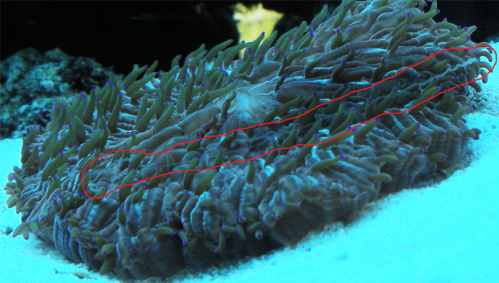
|
|
Re: Happy Fungia Unraveling Fast: Mysterious Tissue
Transfer Matter, or Attack of the Benthic Ctenophores?
10/31/11
Hi Bob! Thanks as always for your quick reply...
<Welcome Alex>
I had a feeling that I was missing a key search term when I was
trying to research this. After reading up a bit on hydroids, I
think you're likely right, though I still haven't found
any pictures of anything similar. Do you think what I'm
dealing with is juvenile (i.e., yet to turn Medusoid), or would
you guess these are already in an adult stage?
<Likely the latter>
I'd prefer to dip just the coral versus treat the whole tank
if possible...
<Then I would do this soon... rather than risk the polyp
spreading (they can/do!)>
I've had the Fungia for a little over a month, and this is
the first time I've seen hydroids so I suspect they came
already attached to it since there aren't any elsewhere in
the tank.
<Yes; highly likely>
Is that unlikely based on the time it took for them to be
evident? I just don't want to unnecessarily over-medicate...
Do you think it will be OK to treat the Fungia on its own so as
not to massacre my tank's existing worm population?
<I do>
Or possibly, when you say "spot-treat," you mean
don't even treat the whole coral but just try and zap the
individual hydroids themselves?
<Yes; this last>
Interestingly enough, I believe this morning the Fungia was
actually EATING one of the hydroid strands, but there were still
two small ones (not fully extended) visible at the edges. I'm
curious how it will look when I get home from work. If the Fungia
did eat any hydroids, would that be a good thing or is it just
going to be stung from the inside now as well?
<As long as they're not too numerous; too
stinging...>
Whether they came in with the Fungia or not, I suspect that the
slightly-elevated nutrient content is helping the hydroids
thrive. For the last two months until about five days ago, my
nitrate levels were around 20ppm, but just recently they jumped
to maybe 25 or 30ppm. I took your suggestion to add a Sock-It to
my sump (had to modify the overflow outlet but it has been worth
it...) and I change and rinse the sock every week (actually got
two extra socks to allow them to dry completely between uses),
but I have noticed lately that the foam level in my EV-180 has
been fluctuating a lot and I'm not sure why.
<Foods/feeding, diurnal rhythms...>
The foam is fine most of the time
but falls to the top of the box seemingly at random and then
re-stacks over the course of 10-15 minutes, so that a lot of
gunky skimmate collects in the foam column as well as the top cup
(and subsequently gets slowly re-added to the water, methinks),
and I suspect this may be at least partly the cause of my
elevated nitrates and phosphates, but I don't know the cause
of the fluctuations themselves. The sump chamber which the
fractionator's pump sits in has a constant water level, even
with the rest of the pumps turned off. I did add some pipe to the
skimmer's return line (post gate-valve) because the skimmer
itself is no longer in the sump, but if that's the issue it
took over two months to start expressing itself. I am emailing
Jason Kim with pictures and more details, so hopefully he can
help me stabilize my foam levels, but if anything I've told
you rings bells in your brain feel free to offer input.
<Just the usual tinnitus unfortunately>
I will forward his reply so you can
post it on WWM. In the meantime, a fresh bag of GFO and activated
carbon into the sump, and lots of crossed fingers that I can save
this befouled Fungia...
I #$&^@*% love you guys. Donations coming soon (but first I
must pay my utilities... you understand...)
PLAH!
Alex:D
<I do. B>
|
|
|

